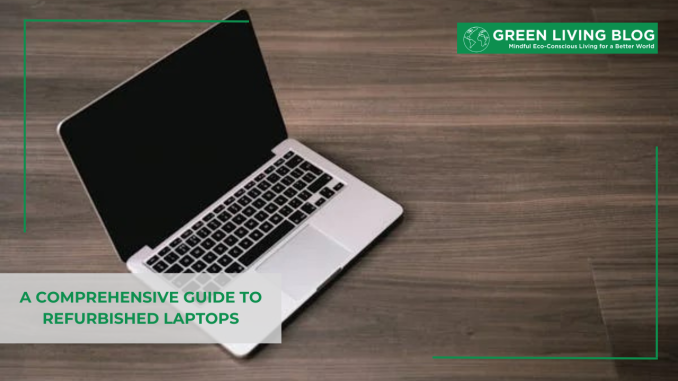
You’re intrigued by the idea of saving money, contributing to environmental conservation and still getting a high-performance machine. But here’s the thing: the market is cluttered with buzzing words – ‘new’, ‘used’, ‘remanufactured’, ‘refurbished’.
Today, let’s focus on one of these: refurbished laptops. Discover why this might be the best route for you!
Refurbished Laptop: An Overview
Let’s start by clearing up the common misconception; refurbished laptops are not simply used laptops. A used laptop is sold as-is, with all of its glory and flaws. On the other hand, a refurbished laptop undergoes certain checks, repairs and upgrades where necessary to ensure it performs like new.
Possibly from customer returns due to minor faults, models no longer sold as new, or pulled off lease after corporate use, these laptops get a second chance through refurbishing. The process involves rigorous diagnostic testing, replacement of faulty components, and a thorough cleaning operation. The good news is that many manufacturers follow stringent refurbishing processes that often involve high-quality inspections to ensure their laptops function optimally.
For instance, buying a refurbished laptop from erudite technology juggernauts like Apple and IBM is quite common and typically comes with warranties.
When you scour the market, you’ll find various kinds of refurbished laptops based on their previous use and condition – Certified Refurbished, Manufacturer or Factory Refurbished, Seller Refurbished among others. Gaining clarity on what these terms imply can significantly assist in making an informed choice.
Benefits of Buying Refurbished Laptops

The first and most notable benefit of buying refurbished laptops is the cost. You can save anywhere from 20% to 50% of the original device cost, while still relishing in virtually the same performance as a new machine.
These are not just lower-end models either. High-end models from top brands that may have been out of your budget when brand new could now be yours at a fraction of the cost.
Moreover, refurbished laptops help to reduce e-waste. By choosing to buy refurbished, you make an eco-friendly choice that contributes to reducing electronic waste. Given that disposing of electronic waste responsibly is still a challenge globally, this choice indeed makes a difference.
Finally, buying from established brands usually means the laptops come with some degree of warranty. This safeguards against any immediate issues you might discover after purchase – something typically lacking with used laptops.
Potential Risks with Refurbished Laptops

Like any market segment, the world of refurbished laptops isn’t without risks and challenges. You could end up with a laptop that has noticeable wear and tear or has a shorter battery life due to prolonged prior use.
The quality of refurbishment also varies greatly depending on where you purchase. While official refurbishers will have stringent processes to ensure quality, individual sellers may not have the same level of expertise or diligence.
Many misconceptions arise from erroneously mistaking ‘used’ for ‘refurbished’. Therefore it becomes essential to understand what refurbishing process the laptop underwent before purchase.
Last but not least, warranties on refurbished laptops are often shorter than those on new machines. A standard warranty period may be around 90 days compared to one year for a new product – although this depends on vendor specifics.
Choosing the Right Refurbished Laptop
Beyond basic considerations like your budget, purpose for use, and brand preference, other factors play into choosing a quality refurbished laptop. You need to discern whether the price matches the age of the laptop model and if it has the latest specifications essential for your usage.
Then, consider the cosmetics of the laptop. While slight aesthetic imperfections do not impact performance, large dents or scratches can indicate mishandling or potential underlying issues.
You should also inquire about the battery life. Keep in mind that batteries do degrade over time and heavily used laptops might not hold as long a charge as new models. This could lead to additional costs relating to battery replacement.
The seller or refurbisher is another crucial aspect to consider. Buying from a reputed source will likely ensure that you get what you’re promised without any nasty surprises.
Identifying Quality Refurbished Laptops
A quality refurbished laptop provides dependable performance similar to a new one, without major aesthetic blemishes or issues. When looking for such laptops, you can generally trust products sold directly by well-known manufacturers like Dell or HP.
Multi-point inspection certificates provided by these companies showcase detailed diagnostics performed on their products as part of the refurbishing process. Picking such certified refurbished electronics and laptops adds an extra layer of assurance.
Pay attention to fine prints related to warranty terms and return policies. These could reveal a lot about how confident the manufacturer is regarding their product’s performance and their commitment towards customer satisfaction.
Finally, customer reviews and ratings reveal collective experiences about the product’s reliability, battery performance and overall value for money. Ultimately, identifying a high-quality refurbished laptop involves diligent research, understanding one’s own requirements and careful decision making.
Key Features to Look for in Refurbished Laptops

When choosing a refurbished laptop, it’s important to consider specific features that can optimize your usage and maximize value for money. Here’s a list of criteria to keep in mind:
- Processor: This is the brain of your laptop, so make sure to get one that matches your needs. From Intel’s i-series CPUs to AMD’s Ryzen range, pick according to your usage pattern.
- RAM: Random Access Memory (RAM) handles multitasking on laptops. For today’s general usage – browsing, media playback, office work – 8GB RAM should suffice.
- Storage: Decide between HDD (higher capacity, less expensive) and SSD (faster, more resilient). If budget permits, opt for SSD as they significantly enhance performance.
- Battery: Important for portability, the battery performance plays a pivotal role. Be sure to inquire about the health of the laptop battery before buying.
- Display: The size and quality of the display influence both usability and user experience. Most importantly, ensure there are no dead pixels or spots on the screen.
The Refurbishing Process Explained
To dispel common myths surrounding ‘refurbishment’, let’s delve into the process behind it. A typical refurbishing process entails several key steps.
Firstly, it begins with a thorough cleaning and inspection of the returned or used unit – from cosmetic external issues to internal hardware checks. Following this, necessary repairs are done or malfunctioning parts replaced. The computer hard drive is wiped clean and a clean version of the latest operating system is installed.
The process doesn’t end at physical refurbishment. Gartner Research, a leading authority in tech research, points out that all refurbished laptops must also undergo system validation tests, simulating prolonged use for hardware reliability assurance. These tests ensure that refurbished models perform on par with new ones.
With all these measures adhered to stringently, refurbished laptops indeed promise quality performance on a budget.
Where to Buy Refurbished Laptops

With refurbished laptops’ increasing popularity, several purchasing avenues have emerged over time. Each comes with its own set of pros and cons, thus demanding informed decision-making from your end.
- Manufacturer’s website: Several computer manufacturers have their own ‘Certified Refurbished’ sections offering machines meeting their own stringent refurbishment specs. These often come with shorter warranty periods but are usually safer bets.
- Retail websites: Websites like Amazon, Newegg and Best Buy offer a wide array of refurbished laptops from different brands. High competition ensures competitive pricing. However, it’s crucial to read seller reviews before purchasing.
- Specialized refurbished retail outlets: Stores like The Renewed Store specialize in selling refurbished tech products and provide substantial warranties with their products
Warranty and Customer Support for Refurbished Laptops
While buying a refurbished laptop, don’t forget to clarify the warranty terms as they can greatly vary based on the seller and manufacturer policy. Unlike brand new machines mostly carrying one-year warranties, refurbished units normally come with shorter coverage periods – often 90 days.
If you’re buying directly from manufacturers or established retailers, customer support is usually accessible and effective. However, do inquire about, and ideally, insist on a ‘no lemon’ policy (replacement if initial repairs are unsuccessful).
Also, study return policies closely. Trusted retailers will often provide at least 15-30 days return period offering you protection against immediate issues.
Refurbished Laptops Vs New Laptops
Choosing between a refurbished and a new laptop will boil down to your individual needs and budget. If you’re looking for the latest model with cutting-edge technology, or if you’re apprehensive about second-hand hardware, a new machine might be better.
However, refurbished laptops can make ideal sense if you need a premium laptop without the hefty price tag. You’ll usually get the same performance as new machines, an environmentally friendly choice and the ability to afford higher-end models at significantly reduced costs.
Referring to an IDC report on global refurbished markets, more businesses and consumers are now opting for refurbished machines as awareness of their benefits grows. The key lies in knowing what to look out for and using reputable sources.
In Conclusion
The world of refurbished laptops opens up an avenue for obtaining high-performance machines at significantly reduced costs while playing your part in environmental conservation.
To have a positive experience buying one, it’s essential to choose trusted sellers or manufacturers, understand their refurbishing processes and check warranty terms. Although it requires due diligence, with correct choices, it can serve as an invaluable option bridging the gap between affordability and performance.
![]()
Author Profile
- Passionate content creator, contributor, freelance writer and content marketing allrounder.
Latest entries
 Green LivingApril 17, 20254 Eco-Friendly Habits to Pair With Your Herbal Tea Ritual
Green LivingApril 17, 20254 Eco-Friendly Habits to Pair With Your Herbal Tea Ritual Best practicesApril 12, 2025Top 6 Eco-Friendly Choices for Sustainable Living in Your Everyday Life
Best practicesApril 12, 2025Top 6 Eco-Friendly Choices for Sustainable Living in Your Everyday Life BusinessMarch 31, 2025How to furnish your Office with sustainable Cardboard Furniture
BusinessMarch 31, 2025How to furnish your Office with sustainable Cardboard Furniture Best practicesMarch 21, 202511 Practical Ways to Limit Your Exposure to Microplastic Pollution
Best practicesMarch 21, 202511 Practical Ways to Limit Your Exposure to Microplastic Pollution






Leave a Reply
You must be logged in to post a comment.